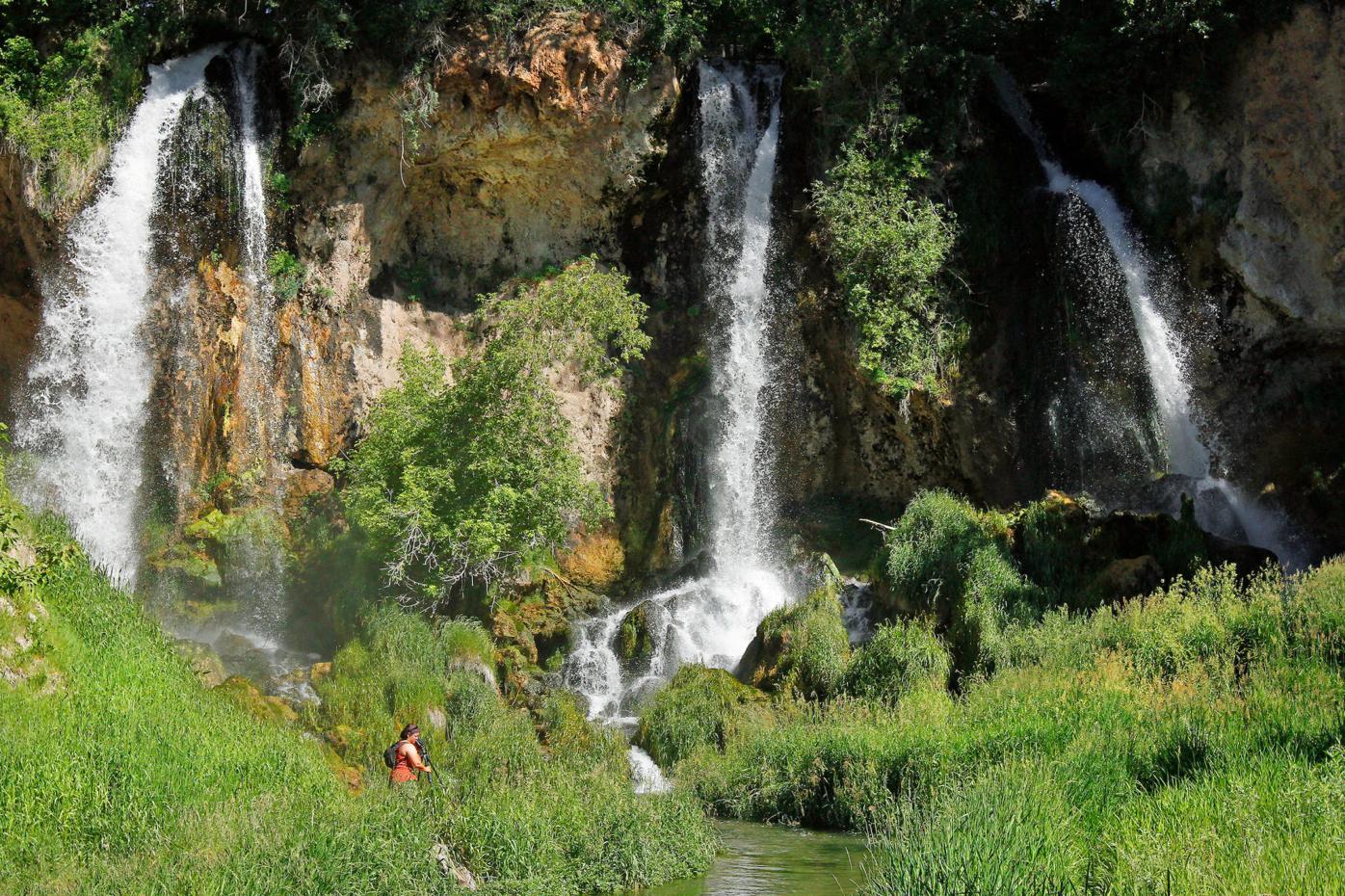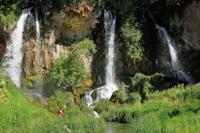Lakes, rivers, cascades and more: Water is Colorado’s grace of summer
In Colorado, it can often feel like you’re not in Colorado.
For example, on the hot and dry Western Slope you might find yourself at Rifle Falls. Suddenly you are immersed in a tropical scene, refreshed by the cool spray of a three-pronged waterfall gushing from a limestone cliff to a verdant floor.
Is this really Colorado, you might ask. Or is this Hawaii?

Unjustifiably ignored, Rifle Falls State Park is one of the most unique landscapes in the state. During the summer, it’s a lush area featuring a trio of waterfalls and several small, explorable caves. The main park feature – the waterfalls. You'll feel like you’re in another world. Outdoor enthusiasts and newcomers alike will love it (photo by Victor Schendel).
Victor Schendel

Unjustifiably ignored, Rifle Falls State Park is one of the most unique landscapes in the state. During the summer, it’s a lush area featuring a trio of waterfalls and several small, explorable caves. The main park feature – the waterfalls. You’ll feel like you’re in another world. Outdoor enthusiasts and newcomers alike will love it (photo by Victor Schendel).
And who knew this semi-desert state could be home to an expanse such as Blue Mesa Reservoir? It’s Colorado’s largest body of water, stretching more than 20 miles.
“It’s such a big lake, but really one of the things that’s special about it is it’s a little bit of a hidden gem,” Eric Loken once explained to us.
Having worked around the lake for much of his life with his marina-owning family, he talked of hidden coves and fishing holes all around — surprising spots for solitude and perhaps a record-breaking fish, as Blue Mesa is known to yield.
Speaking of surprises, Great Sand Dunes National Park & Preserve is known for one — as if the landscape isn’t surprising enough, fit for Hollywood’s latest sci-fi hit. From the surrounding mountain runoff, Medano Creek emerges at the base of the field, forming a wavy, beachy scene in early summer.
“We just came for the dunes,” said an unsuspecting visitor we met a few years ago. “We didn’t know there was a river to cross!”
That’s Colorado for you. Full of surprises.
Water might be the greatest surprise — the lakes, streams, springs and cascades that greet us on our journeys.
What better theme for this year’s 2024 summer guide? And where, oh where, to begin?
Perhaps at the headwaters.
Colorado’s mountains protect the start of several rivers as they make their critical course through the Southwest. That includes the region’s most major, the Colorado River, which begins high in Rocky Mountain National Park.
The state’s largest protected wilderness area — sprawling the size of Connecticut — western Colorado’s Weminuche Wilderness guards the remote headwaters of the Rio Grande, San Juan and Animas rivers, among others of smaller sizes but no smaller importance.
An entire ecosystem depends on river health, not to mention Colorado’s vast, colorful array of trout sought by anglers near and far. They swim in more than 300 miles of Gold Medal-rated streams around the state. But it’s far from just fly-fishing to our benefit.
The rivers represent our lifeblood. They feed our drinking sources. They power the grid.
Which reminds us of another Colorado surprise: This state is significant to the history of electricity. Look to the Ames Hydroelectric Plant, built in 1890 outside Telluride.
“You could say it’s the proof of concept that allowed the country to be electrified,” said Kiernan Lannon, executive director of Telluride Historical Museum.
Ames Hydroelectric Plant is considered the first to produce and transmit alternating current power over a distance for commercial purposes. It apparently inspired Smuggler-Union Hydroelectric Plant to power mines back in Telluride. That’s the house you see atop Colorado’s tallest waterfall: Bridal Veil Falls.
You could say that plant went from utility to tourism-driving curiosity. The clifftop house is a rustic, idyllic complement to the picture-perfect waterfall. The National Register of Historic Places deems it “one of the most spectacular vistas in Colorado.”
When it comes to spectacular, Bridal Veil Falls has competition. Inevitably, the competition involves more water.
The aforementioned Rifle Falls is on the bucket list with Hanging Lake, one more super popular, tropic-seeming site. Another widely circulated postcard image out of Aspen would not be complete without water: Maroon Lake reflecting those pyramid-like peaks.
Maroon Bells and Hanging Lake are among several Colorado destinations in recent years to add reservations and shuttles to manage crowds. The management is new, but demand has long existed for the state’s cherished waters.
Rob White managed Arkansas Headwaters Recreation Area for two decades before his 2020 retirement. He relayed the stories he heard about the years before Colorado Parks and Wildlife’s Arkansas River rafting management: “There would be fist fights between the outfitters over who was gonna launch and who was gonna park.”
We’ve had to learn how to share on the Arkansas, considered America’s most whitewater-rafted river. Unforgettable memories are made from Browns Canyon to the Royal Gorge.
Colorado is also home to one of the nation’s most coveted rafting permits. The chance to venture down Yampa River through Dinosaur National Monument has been complicated by supply and demand over the years. Demand has increased, land managers say, while drought has dwindled supply.
Just as drought threatens our supplies for drinking water and power, it threatens the lakes and rivers also providing our active ways of life.
“It’s a reckoning right now,” we heard from an avid fisherman, Scott Willoughby. This was in the summer of 2022, a time of fishing closures across low, hot waters that strained habitat.
In March, a Senate committee hearing was dedicated to climate change’s threat to outdoor recreation. The call to action was put in economic perspective as committee members stressed increased fire danger, lower water levels and migration patterns threatened a nationwide industry reportedly generating $1.1 trillion annually.
In Colorado, outdoor recreation is said to generate $13.9 billion each year and account for 130,000 jobs. The state’s rafting industry alone has reported its annual economic impact as high as $231 million.
That figure changes year to year. It changes with factors including flows and fires.
Nik White has reflected on the changes over his life of kayaking around the state. He’s the access and conservation director for advocacy group Colorado Whitewater.
“I’d say the highs aren’t there anymore, or they’re much shorter lived than they used to be,” he said.
And so we take advantage of generous years of snowmelt. Years such as 2023.
Runoff greatly boosted reservoirs in the state’s southwest, helping to explain a striking year-to-year increase in visitation. For example, Ridgway State Park reported 614,358 visitors, up 48% from 2022.
Another lake is centerpiece of Colorado’s most visited state park. Boaters, anglers, campers and more account for about 3 million visits to Lake Pueblo every year. We were surprised by someone we met there once: A young, local woman training to stay atop the country’s competitive wake surfer rankings.
Wake surfing in Colorado. You heard that right.
Just like you heard this right: The state has been ranked in the top three for producing the nation’s most certified scuba divers.
That was no surprise to a mother we once met at Aurora Reservoir, where her kids were getting certified for a Caribbean vacation. Lindsay Beebe stated the obvious behind the scuba diving trend: “People in Colorado are adventurous.”
This helps to explain why they rack up many miles and much vertical gain to reach lakes spotting the high country.
One might say Colorado’s 54 14,000-foot mountains are the ultimate prizes, while others know many more treks would be required to see all of the state’s high-alpine lakes. They are scenes that take the breath away as much as any great summit.
Again, the state’s waters are there to soothe us after those hard hikes.
If we’re in the mountains, chances are there’s a hot spring not far away. After all, the ancient uplift that formed the mountains is central to the underground process that renders the steaming, mineral-rich springs.
Of course Colorado is home to what’s considered the world’s deepest hot spring (Mother Spring in Pagosa Springs). Of course Colorado is home to what’s considered the biggest hot spring-fed pool (Grand Pool in Glenwood Springs).
That’s Colorado for you. Full of surprises.
/** slide box */
#slidepanel {
border-top: 3px solid #ff0000;
}




